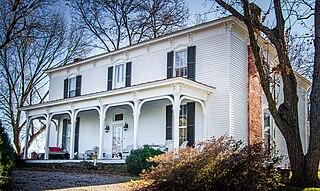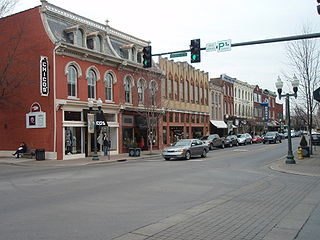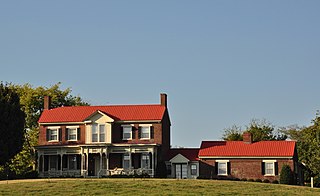
Lewisburg Avenue Historic District is a 28-acre (11 ha) historic district in Franklin, Tennessee that was listed on the National Register of Historic Places in 1988.

The Maney-Sidway House, also known as Jasmine Grove and as Myles Manor, is a building in Franklin, Tennessee originally built c.1836, that was listed on the National Register of Historic Places in 1988.

The McGavock–Gaines House, also known as Riverside, is a historic mansion in Franklin, Tennessee. It was listed on the National Register of Historic Places in 1988. The property then included two contributing buildings, one contributing structure, and one non-contributing building, on an area of 3.2 acres (1.3 ha).

The Henry P. Gray House is a building in Franklin, Tennessee, United States, dating from c.1845. It was listed on the National Register of Historic Places in 1988. It shows Greek Revival and Central passage plan architecture.

The John Henry Carothers House, also known as Ezeal Carothers House, is a property in Franklin, Tennessee that was listed on the National Register of Historic Places in 1989. When listed the property included four contributing buildings, two contributing structures, and two non-contributing buildings, on an area of 26 acres (11 ha).
The James E. Collins House in Franklin, Tennessee, United States, was listed on the National Register of Historic Places but was removed in 1995. The property was also known as Anderson House.

The Nicholas Tate Perkins House is a property in Franklin, Tennessee, United States, that was listed on the National Register of Historic Places in 1988. The property is also known as Two Rivers. It was built or has other significance as of c.1820. It includes Central passage plan and other architecture. When listed the property included two contributing buildings and one non-contributing structure, on an area of 3.4 acres (1.4 ha). The property was covered in a 1988 study of Williamson County historical resources.
Henry Pointer House is a building in Thompsons Station, Tennessee that was listed on the National Register of Historic Places. It was removed from the National Register in 2006.

George Pollard House is a property in Franklin, Tennessee, United States, that was listed on the National Register of Historic Places in 1988. It was built or has other significance as of c.1845. It includes Central passage plan and other architecture. When listed the property included one contributing building and one non-contributing structure on an area of 3 acres (1.2 ha).

The Thomas L. Critz House, built c.1887, is a historic Italianate style house in Thompsons Station, Tennessee that was listed on the National Register of Historic Places in 1988. It is a two-story frame residence with a Central passage plan. It has a one-story porch with square chamfered columns.

The Y. M. Rizer House, also known as Mapleshade, is an Italianate and Second Empire style house dating from c.1874 in Franklin, Tennessee that was listed on the National Register of Historic Places in 1988.

The Robert Hodge House, also known as Sullivan Farm House, is a ca. 1900 Queen Anne and Colonial Revival house in Franklin, Tennessee.

The John Crafton House is a historic property in Franklin, Tennessee, United States, that was listed on the National Register of Historic Places on April 13, 1988.

Franklin Historic District is a historic district in Franklin, Tennessee that was listed on the National Register of Historic Places in 1972. It was created to preserve historic commercial and residential architecture in a 16-block area of the original, downtown Franklin around the north, west, and south of the town square.

The Samuel S. Morton House is a property in Franklin, Tennessee that was listed on the National Register of Historic Places in 1988. It has also been known as Lillie House.
The Christopher McEwen House was a property in Franklin, Tennessee that was listed on the National Register of Historic Places, but later was removed from the Register, in 1995.

Thomas Shute House is a property in Franklin, Tennessee, United States, that was listed on the National Register of Historic Places in 1988. The property has also been known as Creekside. It dates from at c.1845. When listed the property included three contributing buildings, and two contributing structures on an area of 4.8 acres (1.9 ha). The property was covered in a 1988 study of Williamson County historical resources. It is one of about thirty "significant brick and frame residences" surviving in Williamson County that were built during 1830 to 1860 and "were the center of large plantations " and display "some of the finest construction of the ante-bellum era." It faces on the Franklin and Columbia Pike that ran south from Brentwood to Franklin to Columbia.

The Nathaniel Smithson House is a property in Peytonsville, Tennessee, which was listed on the National Register of Historic Places in 1988.

Mountview is a property in Brentwood, Tennessee that was built in 1860 and that was listed on the National Register of Historic Places in 1986. It has also been known as the Davis-Rozelle Residence.

The Dr. Hezekiah Oden House is a building and property in Franklin, Tennessee, United States, dating from c.1850 that was listed on the National Register of Historic Places (NRHP) in 1988. It has also been known as Walnut Winds. It includes Greek Revival, Central passage plan and other architecture. The NRHP listing included one contributing building, one contributing site and two non-contributing buildings on an area of 1 acre (0.40 ha).













